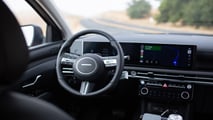
A simple, effective update is all a car needs sometimes. The 2025 Hyundai Tucson is a sterling example. A slight facelift, some new tech, and a brand-new interior help keep the Tucson competitive with other best-sellers in the compact SUV segment. But is it enough to secure victory over top dogs like Toyota RAV4 and Honda CR-V?
| Quick Specs | 2025 Hyundai Tucson Limited Hybrid |
| Engine | Turbocharged 1.6-Liter Four-Cylinder Hybrid |
| Output | 231 Horsepower / 271 Pound-Feet |
| 0-60 MPH | 8.0 Seconds (est.) |
| Weight | 3,906 Pounds |
| Base Price / As Tested | $30,000 (Gas) / $43,060 |
The Tucson basics are all still here. You get three powertrain options: A 2.5-liter four-cylinder, a 1.6-liter turbo hybrid, and a 1.6-liter turbo plug-in hybrid. The 2.5-liter can be had in front-wheel or all-wheel drive while both hybrids get standard all-wheel drive. Then you have your choice of trim levels, from the barebones $30,000 SE FWD, up through the mid-grade SEL that ranges from $32,000 to $34,000, and finally, the top-trim Limited that ranges from $38,000 for a Limited FWD to $47,000 for a Limited plug-in hybrid.
Nothing of note has changed mechanically, with small updates applied to various systems. Most notably, hybrid models get driver-adjustable regenerative braking through steering-wheel-mounted paddles, just like Hyundai's EVs. Otherwise, it's the same efficient and refined hybrid powertrain as before, and the same slightly lethargic non-hybrid 2.5-liter engine as well.
The colossal update comes with the interior, which is almost entirely new for the 2025 Tucson. It ditches the already decent old interior with a dashboard layout nearly identical to the Elantra and Santa Fe. A wide, curved instrument panel spans most of the dashboard with twin 12.3-inch screens, one for the gauge cluster and the other for the infotainment. A new dash also brings back a feature not seen since the early '90s with an open storage cubby in the passenger-side dash, as well as a new touch-sensitive HVAC panel.

Pros: Nice Interior, Great Fuel Economy, Surprisingly Nice To Drive, Good Ride
On the road, the Tucson hits its marks with a confident stride. The new interior is exceedingly usable, with plenty of storage space and lots of pockets around the cabin. The new screen layout looks crisp and the infotainment screen has smartphone-esque responsiveness. Everything feels high-quality with a nice spread of materials, including some textured fabrics and soft leather surfaces adding tactile intrigue.
It was a lovely place to spend time, with only a couple of demerits. For one, there's too much interior noise, with critical frequencies from the tires and wind noticeable at highway speeds. It was reasonably quiet for the most part, which maybe made those other sounds more obvious, but it was unexpected. Not a dealbreaker, but it's certainly in contrast to the rest of the interior’s quiet excellence.



Meanwhile, other minor details were welcomed—like slots for the rear seatbelt buckles to live in while the second row is folded down, or a quiet mode that mutes the rear speakers for rear passengers. The general attention to detail and design make the Tucson more lovable than I expected.
For the stated power output of the Limited hybrid I drove, it didn’t feel too eager to accelerate. It had adequate power, but didn’t feel like the 231 horsepower I was expecting, even with a brimmed battery pack. This is probably because the Tucson Limited hybrid is fairly heavy at 3,904 pounds, but at least it did return an honest 34 miles per gallon combined on a 150-mile loop. Then there was Hyundai’s advanced driver’s assistance system, dubbed Highway Driving Assist II. The adaptive cruise control worked well and braked smoothly in traffic, but I found the lane keeping to be irritatingly swervy.

Cons: Not All That Power, Adaptive Safety Needs Refinement
There is no doubt, however, that the updated Tucson drives well. Its ride quality approaches exceptional, with excellent damping over a mix of large and small bumps. What was most impressive was how soft it was without compromising handling or body control.
Typically, handling doesn’t factor all that much into a compact SUV purchase, but the Tucson also handles well enough to make note of it. It has a nice, natural steering effort curve and excellent feedback from the electronically assisted rack. The steering wasn’t afraid to weigh up in corners and never felt too light or disconnected. A strangely impressive effort in an otherwise ordinary car.


Hyundai’s effort amounts to an SUV that can truly take the fight to the top contenders in the segment. Hyundai’s infotainment and screen tech is class-leading, as is the ride and handling, and the powertrains do a similar job to the competition. The 2025 Tucson falls slightly short in interior noise—but that’s about it.
Overall, the Hyundai Tucson is a true value proposition with a range of meaningful updates and added features that amount to a more cohesive SUV than the rest. In many ways, the Tucson feels like the best compact SUV in the segment.







Competitors
2025 Hyundai Tucson Limited Hybrid







